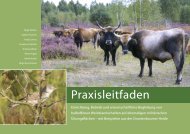TAGUNGSBAND CONFERENCE PROCEEDINGS - Offenlandinfo
TAGUNGSBAND CONFERENCE PROCEEDINGS - Offenlandinfo
TAGUNGSBAND CONFERENCE PROCEEDINGS - Offenlandinfo
Erfolgreiche ePaper selbst erstellen
Machen Sie aus Ihren PDF Publikationen ein blätterbares Flipbook mit unserer einzigartigen Google optimierten e-Paper Software.
Meadows provided by Rural<br />
Development Programme (2007-2013)<br />
as donor sites for species-poor meadows<br />
– case study of Bystrzyca Kłodzka<br />
region<br />
Magdalena Szymura, Agnieszka Dradrach<br />
Wrocław University of Environmental and Life Sciences,<br />
Department of Agroecosystems and Landscape Management,<br />
Poland<br />
In the last 50 years widespread losses and degradation of<br />
grasslands have occurred in Europe. Main causes of this<br />
situation are agricultural intensification, like land drainage,<br />
application of high doses of fertilizers and conversion the<br />
permanent grassland into crop fields. Nowadays several<br />
projects were started to restore species-rich grassland,<br />
however, restoration and extensification programmes<br />
have not always been successful in re-establishing typical<br />
grassland species. Two factors, that impede restoration<br />
process are described: limitation of site (inappropriate site<br />
conditions) and dispersal limitation (no seeds of grassland<br />
species are available). In case of active restoration of<br />
grassland by harvesting of valuable seed mixtures and the<br />
usage of them to restore arable land and degraded grasslands.<br />
The important factor depending on effectiveness of<br />
re-establishing species is similarity of the renaturalizated<br />
site and donor site. Mostly, as the donor sites are managed<br />
exclusively for grasslands, placed in protected high-valuable<br />
nature areas, whereas the degraded sites are located<br />
near human disturbed areas. The distance influences the<br />
successful restoration negatively, because of the difference<br />
in site condition and plant composition. Better way would<br />
be to use it as a source of seeds or hay as near as possible<br />
to the grassland plant community. Through financial<br />
compensation mechanisms, EU have supported extensive<br />
grassland management. In Poland this programme started<br />
in 2004 with accession to the European Union. Nowadays,<br />
in Agri-environmental programme, realised by of the Rural<br />
Development Programme (2007-2013), the extensive<br />
grassland management is promoted in package 3 (extensive<br />
permanent grassland), 4 (protection of endangered bird<br />
species and natural habitats outside of Nature 2000 areas),<br />
and 5 (protection of endangered bird species and natural<br />
habitats in Nature 2000 areas). As a donor meadows for<br />
restoration of the degraded grassland sites areas covered<br />
with package 4th and 5th are useful. Species composition<br />
of these meadows are described in detail in elaboration of<br />
the flora documentation (variants 4.2-4.9 and 5.2-5.9).<br />
Presented paper shows the possibility of using the documentation<br />
of flora, made for Agri-environmental programme,<br />
to find the best donor side in close neighbourhood of<br />
resorted site.<br />
38<br />
Stellwand-Nr.<br />
Poster Panel No. 29<br />
Weed suppression and seed bank in<br />
early grassland restoration - Can the<br />
sowing of low diversity seed mixtures<br />
be used in weed control?<br />
Péter Török, Tamás Miglėcz, Orsolya Valkȯ, András Kelemen,<br />
Szabolcs Lengyel, Béla Tothmeresz<br />
University of Debrecen, Department of Ecology, Debrecen,<br />
Hungary<br />
Grassland restoration offers a great opportunity to mitigate<br />
the loss of grassland biodiversity. Weed control can be<br />
another benefit, which becomes increasingly important<br />
because of the high recent rate of abandonment of arable<br />
lands in Central and Eastern Europe. Grassland restoration<br />
by seed sowing is often recommended where increased<br />
weed domination can be foreseen. But the effectiveness of<br />
restoration by sowing in weed control was rarely analysed.<br />
Our aim was to evaluate the role of sowing two low-diversity<br />
seed mixtures followed by annual mowing, a frequently<br />
used restoration technique, in weed control. We found that<br />
the rapidly forming cover of sown perennials effectively<br />
suppressed short-lived weeds and prevented their germination<br />
except in the first year. A high density of short-lived<br />
weed seeds in the soil suggested that the restoration may<br />
have promoted the preservation of their seed banks and<br />
threatens with a possibility of later weed infestation. We<br />
detected a few perennial weed species in the vegetation<br />
of several fields, which cannot easily be suppressed by<br />
annual mowing in the short run. We also found that fields<br />
sown with the same seed mixture but with different site<br />
history may be dominated by different perennial weed<br />
species. Rapidly establishing perennial graminoid weeds,<br />
such as Agropyron species were only detected in former<br />
alfalfa fields. Conversely, the perennial weedy forb Cirsium<br />
arvense was found in former cereal and sunflower fields<br />
but not in former alfalfa fields. These results show that the<br />
appropriate post-restoration management of new grasslands<br />
may require carefully designed management actions<br />
that are fine-tuned to address the emerging specific threats<br />
at the site level.<br />
Stellwand-Nr.<br />
Poster Panel No. 30




